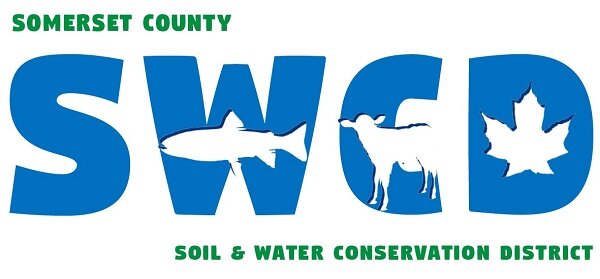David Krebs
Krebs Organic Dairy Farm, Starks
pc L Suomi-Lecker
FOREVER FARMING
Nestled like a gem in the curves of Lemon Stream at the end of Krebs road in Starks, sits Krebs organic Dairy farm. David Krebs has been managing the family farm since he was 14. He loves what he does and it shows.
“I’ve been milking cows since I could walk,” says David, a third-generation farmer.
Sustainable practices and conservation are key components of the farm and way of life for the Krebs family. Over the last twenty years, they have implemented many conservation practices in conjunction with the Natural Resources Conservation Service (NRCS), including the construction of their manure storage system. The soils on the farm are sandy, so storing manure in a concrete facility made a big difference for the protection of groundwater quality.
Construction of a new stream crossing and attendant fencing made it possible to access the whole pasture for grazing while excluding cattle from a tributary that runs through the fields. This helps to protect the water quality of Lemon Stream, which is very important to David, as he makes time in his busy days to hike along the stream, enjoying nature’s offerings.
As of 2018, the farm was placed under a conservation easement through Maine Farmland Trust and will be a ‘forever farm’. “I want to preserve this land for future generations of farming,” says David. Organically certified by MOFGA since 2006, David believes that “if we are taking care of the land, we won’t need all of the inputs to keep it fertile.”
David uses a rotational grazing system for his cattle, moving them after each milking. In addition to helping keep the fields healthy, he feels having cows rotationally grazing on pasture is good for their overall health.
“They love to move into a new paddock,” he says, “they just rush to the new feed.”
Some of David’s girls out on pasture pc jbrockway
In fact, it is “working with the girls” that David loves best about farming. He says with a shake of his head, “I considered getting a robotic parlor to save time and help out but then I realized that I would be getting rid of my favorite part of the day.”
One might assume that milking is the favorite part of the cows’ day as well, when David confesses that he sings to them (“They prefer oldies county music.”) during milking. He asserts that the key to having a successful dairy operation is happy and comfortable cows.
Making Space
David has participated in the Ag Allies grassland bird program since 2017. As a dairy farmer, David needs to have high quality, high protein feed for his milking herd, which makes it more challenging to delay mowing for nesting habitat. Despite the constraints, he was interested in having a ‘whole farm’ grassland bird assessment to help decide which areas to designate as habitat. The assessment resulted in a beautiful 20-acre habitat just outside of town. This field is ideal not only for bobolinks and Savannah sparrows, but containing a small water feature in the middle, it also supports red-winged blackbirds, bitterns and a host of edge species.
After the first year, David was asked if he would be willing to try a ‘fallow habitat paddock’ in his 50-acre pasture field at the home farm where bobolinks are abundant. David readily agreed, and during the first survey, a bobolink nest with eggs was discovered – a true miracle for non-invasive surveys, as the nests are small, well-camouflaged and very difficult to find. We worked with David on a plan for the 5-acre block in the field to incorporate the known nest and ensure ease of cattle rotation around the block.
Delayed mowing block pc L Suomi-Lecker
This block has been re-established each year since, with a few minor adjustments, and it has been a truly educational and delightful experience. The block becomes an ‘island’ after the cattle graze around it and it is a visceral and living demonstration of the importance and vitality of standing grassland habitat.
Coming back later in the season as the birds are getting ready to fly, the cropped grass around the block is a neat and silent expanse. Approaching the block, one begins to hear and see the bustling activity within. Bees, butterflies, dragonflies and other insects create a hum and bobolinks and Savannah sparrows pop in and out of the grass. Phoebes and swallows circle overhead, enjoying the rich hunting grounds the area provides. The block vividly illustrates how biologically active standing grasslands are in contrast with the silence of mowed areas.
pc L Suomi-Lecker
David feels that being part of the Ag Allies program has worked out well over the years. Thinking for a moment, he smiles. “Before the program, when I mowed the grass, I only saw the grass. But this [program] really opened my eyes. I see so much more now – what is in the grass and all around. And I like spending time noticing all of these other things.”
Profile by Laura Suomi-Lecker, 2022




